
First-floor, southeast parlor, Philipse Manor, Yonkers, New York, ca. 1750. (Courtesy, Philipse Manor Hall State Historic Site, administered by the New York State Office of Parks, Recreation, and Historic Preservation; photo, Gavin Ashworth.)

Second-floor, southeast parlor, Philipse Manor. (Photo, Gavin Ashworth.)

Detail of the frieze appliqué of the chimneypiece illustrated in fig. 2.
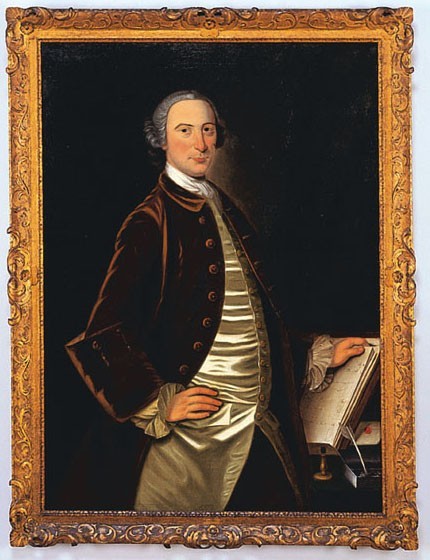
Picture frame by Stephen Dwight, New York, 1762. White pine, gilded. 52 3/4" x 40". (Collection of the New-York Historical Society; photo, Metropolitan Museum of Art.) The frame is on Lawrence Kilburn’s portrait of James Beekman.
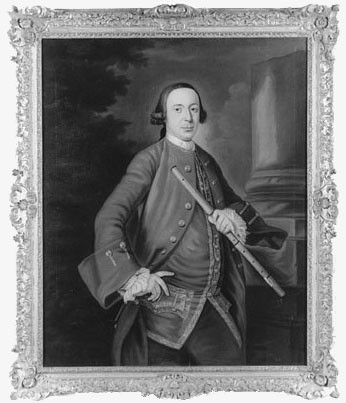
Picture frame, British, ca. 1760. Red pine, gilded. 54 1/4" x 45 3/4". (Collection of the New-York Historical Society; photo, Metropolitan Museum of Art.) The frame is on Lawrence Kilburn’s portrait of Abraham Beekman.

Parlor from Hampton Place, Elizabeth, New Jersey, 1760–1765. (Courtesy, Winterthur Museum.)

Detail of a truss and crossette appliqué on the chimneypiece illustrated in fig. 6.
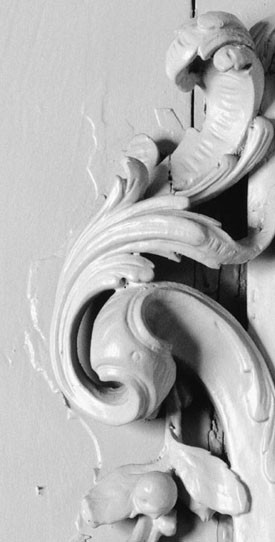
Detail of the left truss of the chimneypiece illustrated in fig. 2. (Photo, Gavin Ashworth.)
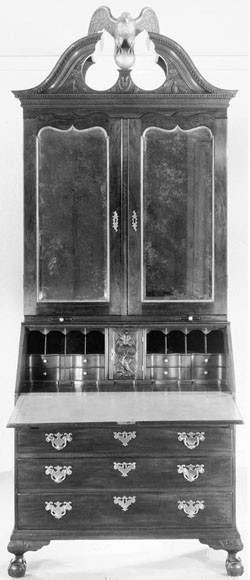
Desk-and-bookcase, New York, 1750–1760. Mahogany with tulip poplar, gum, oak, and mahogany. Dimensions unrecorded. (Private collection; photo, John Walton Antiques.)
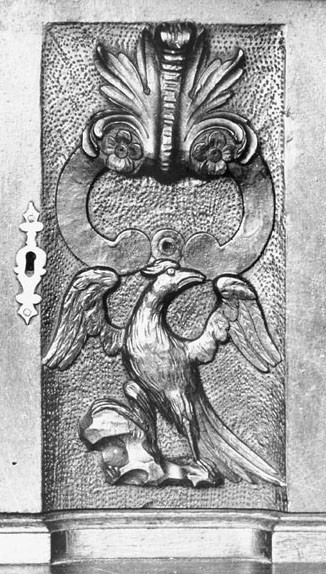
Detail of the relief-carved heron on the prospect door of the desk-and-bookcase illustrated in fig. 9.
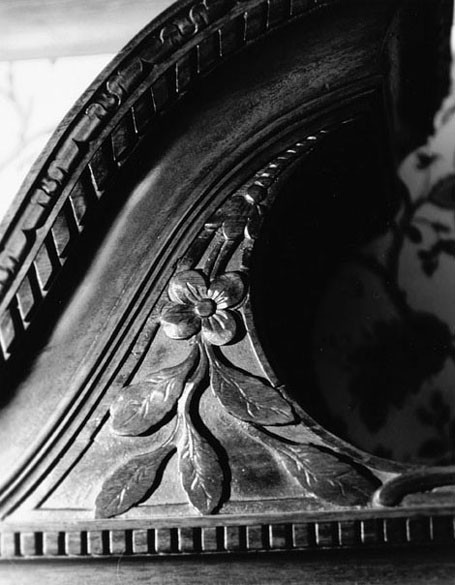
Detail of an appliqué on the scrollboard of the desk-and-bookcase illustrated in fig. 9.

Chimneypiece from Mount Pleasant, New York, 1763–1765. White pine, painted. (Collection of the New-York Historical Society; photo, Metropolitan Museum of Art.)

Detail of a crossette appliqué on the chimneypiece illustrated in fig. 12. (Photo, Gavin Ashworth.)
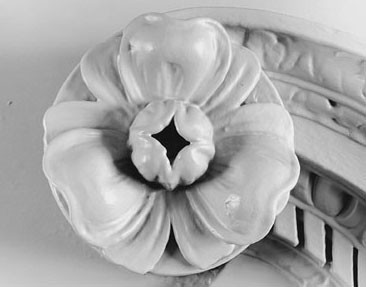
Detail of a rosette on the chimneypiece illustrated in fig. 1. (Photo, Gavin Ashworth.)
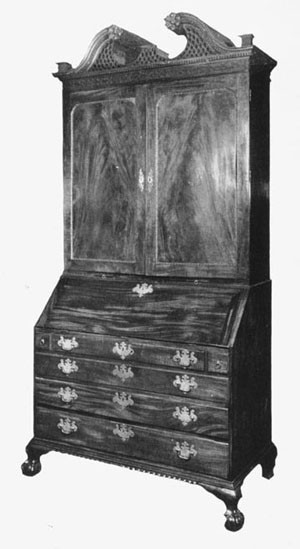
Desk-and-bookcase, New York, 1760–1770. Mahogany with unrecorded secondary woods. H. 106", W. 50", D. 24 1/2".

Detail of the frieze appliqué on the chimneypiece illustrated in fig. 12. (Photo, Gavin Ashworth.) The carver used short, paired gouge cuts to simulate hair and feathers. This distinctive technique appears in work attributed to Henry Hardcastle.

Detail of a truss on the chimneypiece illustrated in fig. 12. (Photo, Gavin Ashworth.)
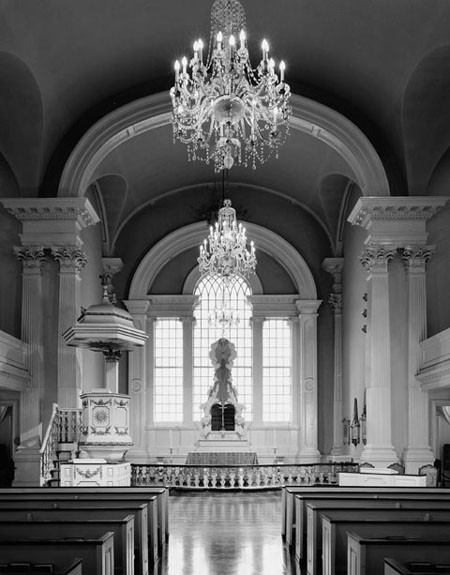
Interior of St. Paul’s Chapel, Broadway and Fulton Street, New York, 1764–1766. (Courtesy, St. Paul’s Chapel, Parish of Trinity Church; photo, Gavin Ashworth.)

Pulpit in St. Paul’s Chapel, New York, ca. 1765. (Photo, Gavin Ashworth.)
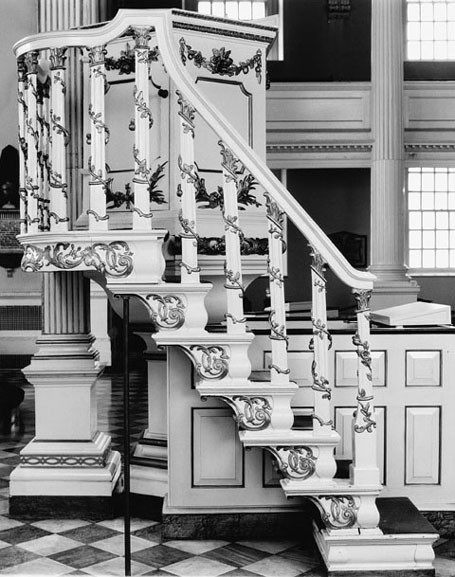
Detail of the stair leading to the pulpit illustrated in fig. 19. (Photo, Gavin Ashworth.)

Detail of the relief-carved frieze of the pulpit illustrated in fig. 19. (Photo, Gavin Ashworth.)
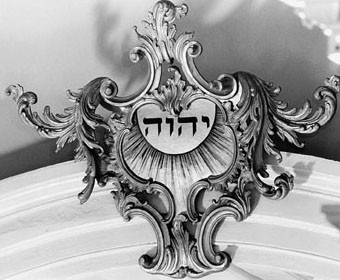

Detail of the acanthus leaves on the cartouche illustrated in fig. 22. (Photo, Gavin Ashworth.)
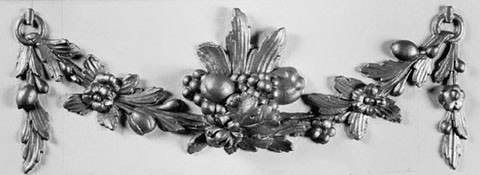
Detail of one of the upper appliqués on the pulpit illustrated in fig. 19. (Photo, Gavin Ashworth.)
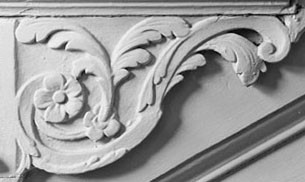
Detail of a stair bracket in Philipse Manor. (Philipse Manor Hall State Historic Site, Yonkers, NY. New York State Office of Parks, Recreation and Historic Preservation.)

Entrance hall from Van Rensselaer Manor, Albany, New York, 1765–1769. (Courtesy, The Metropolitan Museum of Art, Gift of Mrs. William Bayard Van Rensselaer, in memory of her husband, 1928.(28.I43)All rights reserved, The Metropolitan Museum of Art; photo, Gavin Ashworth.)
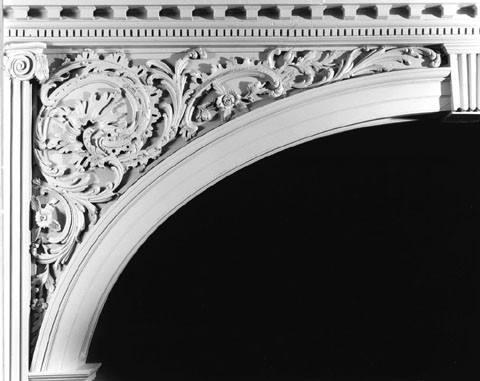
Detail of a spandrel appliqué in the hall illustrated in fig. 26. (Courtesy,The Metropolitan Museum of Art, Gift of Mrs. William Bayard Van Rensselaer, in memory of her husband, 1928. (28.I43) All rights reserved, The Metropolitan Museum of Art; photo, Gavin Ashworth.)

Design for a spandrel illustrated on plate 10 of Matthias Lock and Henry Copland’s A New Book of Ornaments (1st ed. 1752). (Courtesy, Winterthur Museum.)
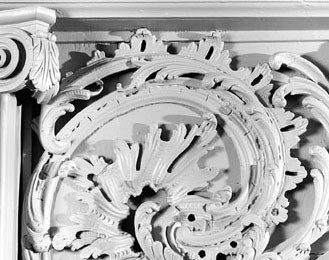
Detail of the acanthus leaves on the spandrel appliqué illustrated in fig. 27. (Courtesy, The Metropolitan Museum of Art, Gift of Mrs. William Van Rensselaer, in memory of her husband, 1928. (28.I43) All rights reserved, The Metropolitan Museum of Art; photo, Gavin Ashworth.)
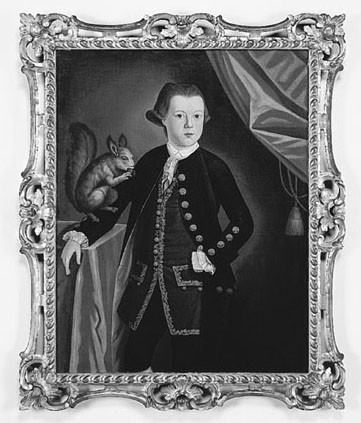
Picture frame by James Strachan, New York, 1767. White pine, gilded. 43 1/2" x 35 1/2". (Collection of the New-York Historical Society; photo, Metropolitan Museum of Art.) The frame is on John Durand’s portrait of James Beekman, Jr.
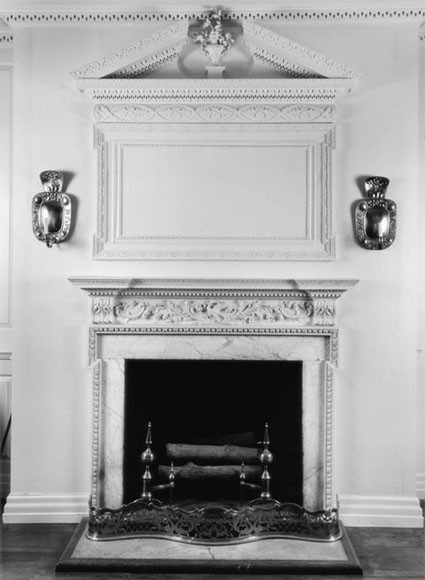
Chimneypiece in the first-floor parlor of Van Cortlandt House, Bronx, New York, 1760–1765. (Courtesy, National Society of Colonial Dames in the State of New York; photo, Gavin Ashworth.)
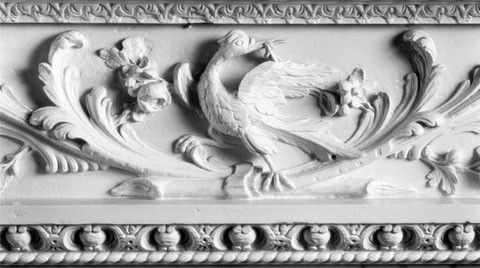
Detail of the frieze appliqué on the chimneypiece illustrated in fig. 31. (Photo, Gavin Ashworth.)

Detail of the frieze appliqué on the chimneypiece illustrated in fig. 31. (Photo, Gavin Ashworth.)

Detail of a truss on the chimneypiece illustrated in fig. 31. (Photo, Gavin Ashworth.)
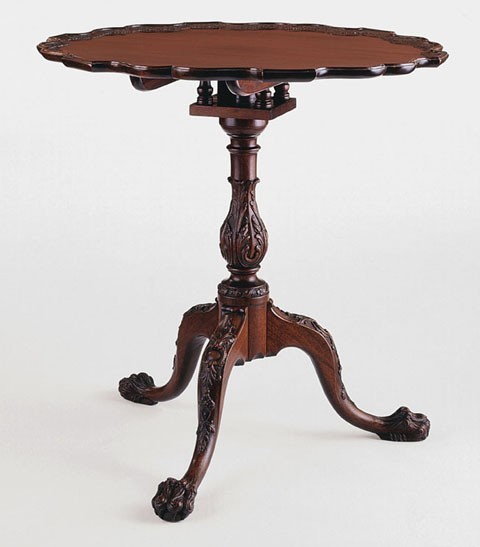
Tea table, New York, 1760–1765. Mahogany. H. 29", Diam. 29". (Chipstone Foundation; photo, Gavin Ashworth.)
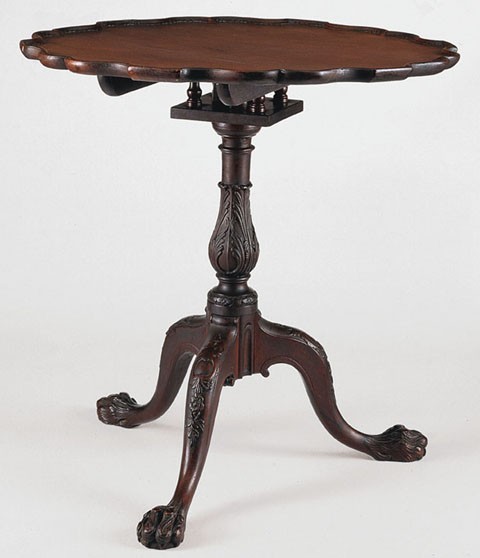
Tea table, New York, 1760–1765. Mahogany. H. 29", Diam. 29". (Private collection; photo, Gavin Ashworth.)
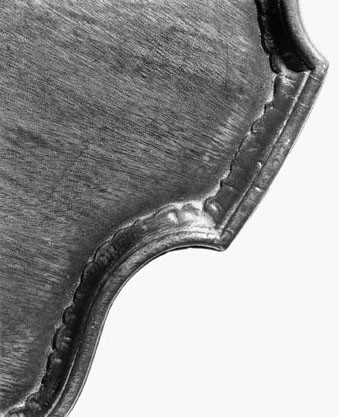
Detail of the edge bead and carving on the top of the tea table illustrated in fig. 36. (Photo, Gavin Ashworth.)
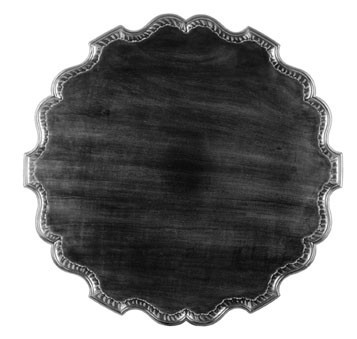
Detail of the top of the tea table illustrated in fig. 35. (Photo, Gavin Ashworth.)
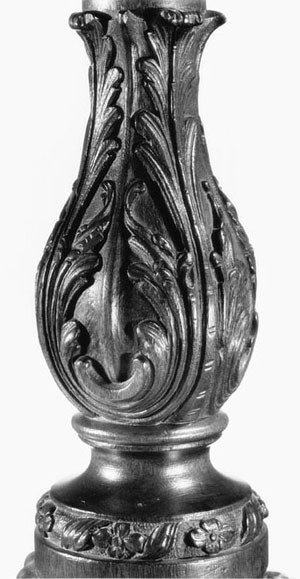
Detail of the baluster of the tea table illustrated in fig. 35. (Photo, Gavin Ashworth.)

Detail of the baluster of the tea table illustrated in fig. 36. (Photo, Gavin Ashworth.)
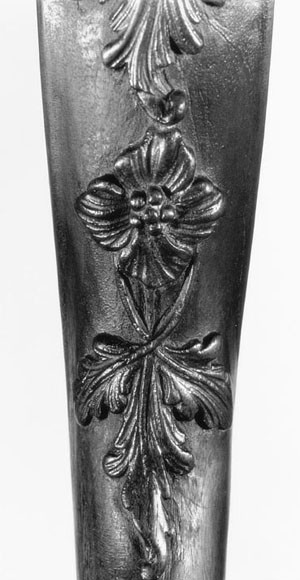
Detail of the knee carving on the tea table illustrated in fig. 35. (Photo, Gavin Ashworth.)
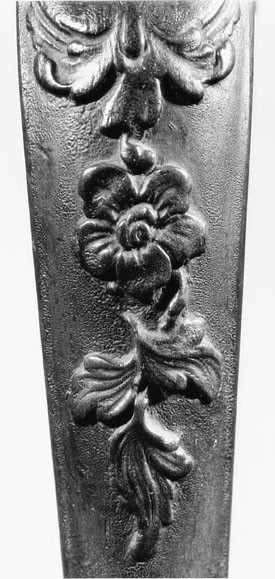
Detail of the knee carving on the tea table illustrated in fig. 36. (Photo, Gavin Ashworth.)

Detail of a paw foot on the tea table illustrated in fig. 35. (Photo, Gavin Ashworth.)

Detail of a paw foot on the tea table illustrated in fig. 36. (Photo, Gavin Ashworth.)
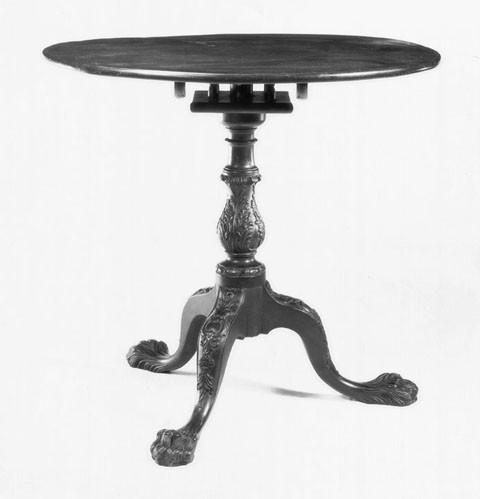
Tea table, New York, 1760–1765. Mahogany. H. 29", Diam. 30". (Courtesy of Sack Heritage Group.) www.sackheritagegroup.com
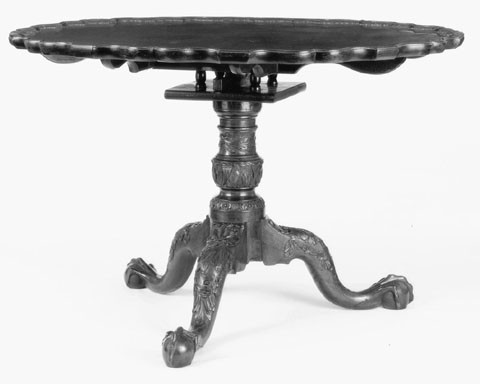
Tea table, New York, 1760–1770. Mahogany. H. 29", Diam. 45 3/8". (Courtesy, National Society of Colonial Dames in the State of New York, Van Cortlandt House; photo, Gavin Ashworth.)

Detail of the knee carving on the tea table illustrated in fig. 46. (Photo, Gavin Ashworth.)
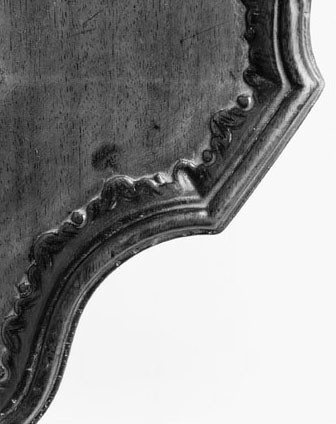
Detail of the edge bead and carving on the top of the tea table illustrated in fig. 46. (Photo, Gavin Ashworth.)
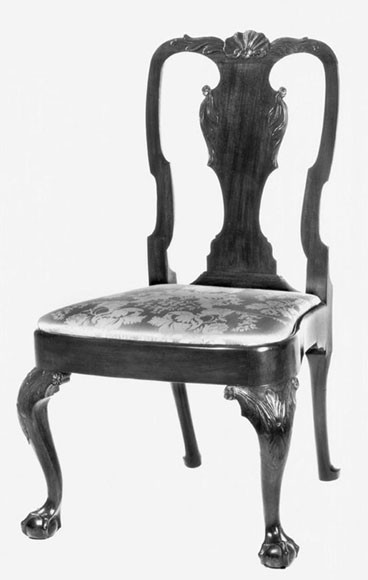
Side chair, New York, 1760–1790. One of a pair. Mahogany, cherry, white oak,. H. 38 7/8", W. 21", D. 21 1/2". (Courtesy, The Metropolitan Museum of Art, Harris Brisbane Dick Fund, 1940.) (40.100.1) All rights reserved, The Metropolitan Museum of Art.
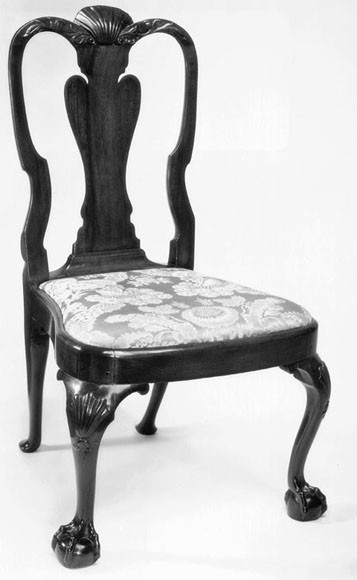
Side chair, New York, 1745–1765. Mahogany; ash slip seat. H. 38 3/4", W. 21 1/2", D. 17 1/2". (Courtesy, Bernard and S. Dean Levy, Inc., New York; photo, Helga Studio.)

China table, New York, 1750–1765. Mahogany with gum. H. 27", W. 34 3/8", D. 21 1/2". (Courtesy, Winterthur Museum.)

China table, New York, 1750–1765. Mahogany. H. 27", W. 35 1/4", D. 22". (Courtesy, Bernard and S. Dean Levy, Inc., New York; photo, Helga Studio.)

Detail of the knee carving on the china table illustrated in fig. 51.

Detail of the knee carving on the china table illustrated in fig. 52.
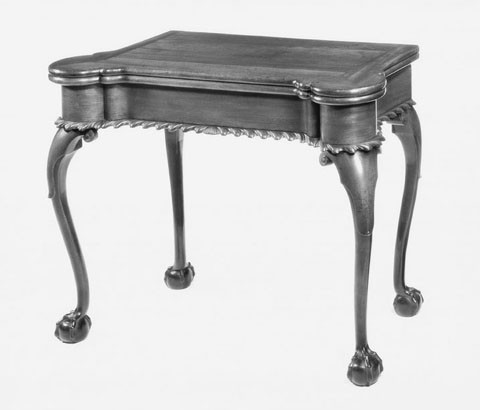
Card table, New York, 1760–1790. H. 28 7/8", W. 37", D. 19" (closed). Mahogany, mahogany veneer, birch, tulip poplar. (Courtesy, The Metropolitan Museum of Art, gift of James DeLancey Verplanck and John Bayard Rodgers Verplanck, 1939.) (39.184.12) All rights reserved, The Metropolitan Museum of Art.
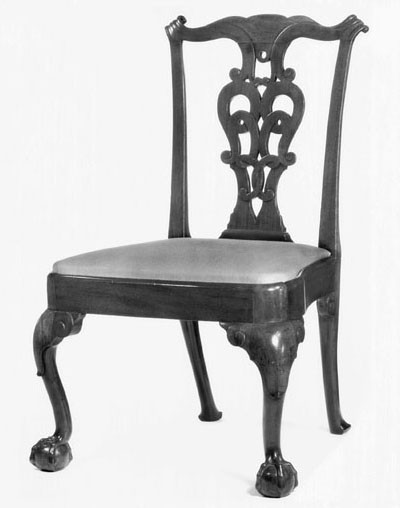
Side chair, New York, 1760–1790. From a set. H. 38 1/2", W. 24 1/2", D. 21 3/4". Walnut, white oak, white pine. (Courtesy, The Metropolitan Museum of Art, gift of James De Lancey Verplanck and John Bayard Rodgers Verplanck, 1939.) (39.184.7) All rights reserved, The Metropolitan Museum of Art.
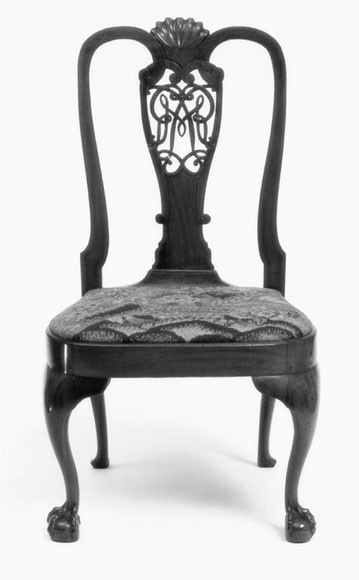
Side chair, New York, 1750–1775. H. 41 1/2", W. 22 1/2", D. 21 1/2". Mahogany; with beech, cherry, eastern pine and soft maple. (Courtesy, The Museum of Fine Arts, Houston; The Bayou Bend Collection, gift of Miss Ima Hogg.)
The rococo style reached its peak in the American colonies between 1760 and 1775, owing to the arrival of specialized immigrant artisans, the influence of design books and furniture imports, and the economic and political situations at home and abroad. An unprecedented number of artisans immigrated during the 1760s. Most probably felt there was less competition and more opportunity for personal and social advancement in America, whereas others immigrated to escape punishment for minor criminal offenses or because of bankruptcy. In the economic decline that resulted from the Seven Years War (1756–1763), many small shops in Britain were displaced by larger firms, and patronage waned, particularly among the middle class. By contrast, America’s economy flourished during and after the French and Indian War (1754–1763).
In 1756, New York merchant Philip Cuyler remarked that the war “may prove as fortunate to this place as the Last [King George’s War].” Colonial merchants and entrepreneurs made fortunes privateering and provisioning the British forces and subsequently reaped the benefits of new and expanded commerce with the hinterland and the Atlantic community. James Beekman, for example, sold large quantities of dry goods in New York and in Albany, where Britain maintained a strong military presence. In his History of the Late Province of New York (1757), William Smith, Jr., wrote, “Never was the trade in this province in so flourishing a condition as at the latter end of the late French War.” Similarly, John Watts noted that New Yorkers “have run too much into habits of luxury. . . . Changes and inconstancies of the war had allmost turned their Heads.”[1]
Together with the scions of wealthy, established families, this new merchant elite was largely responsible for the spate of building that occurred in New York during the 1750s and 1760s. Between 1743 and 1760, the number of houses increased from approximately 1,140 to 2,600, and the city’s population grew from 11,000 to 18,000. Artisans outside the building trades profited from the growing demand for furnishings and consumer goods and from nonimportation agreements established in response to increasing tariffs and duties imposed by the Crown. This economic and political climate encouraged domestic industries and attracted a variety of tradesmen from abroad.[2]
At least half of the carvers who advertised in New York during the third quarter of the eighteenth century were immigrants. The first to arrive was Henry Hardcastle (fl. ca. 1750–ca. 1756), who was admitted as a freeman in 1751. Little is known about his career, but the furniture and architectural work attributed to him suggests that he trained in London or another large British city during the 1740s. This training is particularly evident in his carving in Philipse Manor in Yonkers (figs. 1, 2). Although a few individual elements could be interpreted as rococo, such as the wavelike plinths of the (missing) birds in the door pediments and asymmetrical scrollwork and heron of the overmantle frieze (fig. 3), the vast majority of this work has a bold, naturalistic quality reminiscent of stone carving in British Palladian interiors of the 1720–1740 period.[3]
Hardcastle’s patron, Frederick Philipse III, was the third lord of Philipseburg Manor. His grandfather emigrated from Friesland to New Amsterdam during the Dutch period of rule and subsequently amassed a fortune through land speculation, slave trading, and two financially advantageous marriages. After the British conquered New Netherland in 1664, Frederick I supported the new government and was eventually rewarded with a royal patent granting manorial status to his estate. His son, Frederick II, was educated in England but returned to New York in 1716. While maintaining the family’s mercantile business, he pursued a legal career culminating in his appointment to the New York Supreme Court in 1755. Frederick II enlarged and renovated Philipse Manor, but his son probably commissioned all the architectural carving in the house and installed the rococo papier-mâché ceiling in the southeast parlor on the first floor (fig. 1). The ceiling ornaments, which appear to be later than the carving, could have been provided by Roper Dawson, who advertised “a great variety of Paper Hangings and . . . Bass Relievo for Ceilings” in 1762; by carvers Nicholas Bernard or John Minshall, who advertised papier-mâché in 1769; or by an English agent or firm working directly with Philipse.[4]
Frederick III is the only individual patron associated with Hardcastle; however, furniture with carving attributed to Hardcastle’s shop descended in the Van Rensselaer, Stuyvesant, and Vreeland-Gautier families. By the middle of the eighteenth century, many New Yorkers from old European families turned to England for the latest styles and fashions. Their demands helped stimulate new developments in the furniture-making trades and supported specialists like Hardcastle.[5]
Judging from his surviving work, Hardcastle maintained a relatively small shop. His only known apprentice, Stephen Dwight (DeWight, DeWhile), ran away in June 1755 and opened a shop between the Ferry Stairs and Burling Slip the following month. Hardcastle subsequently moved to Charleston, South Carolina, where he died in October 1756. Although his residence in New York was relatively short, as Dwight’s master Hardcastle was the progenitor of the most enduring carving tradition in eighteenth-century New York.[6]
Stephen Dwight’s career lasted from 1755 to at least 1774. Advertisements indicate that he moved his shop “into the house of Mr. Johnson Carpenter . . . near the Moravian Meeting” in 1762, that he painted portraits and taught drawing, and that he was in partnership with carver Richard Davis by 1774. Dwight and Davis may have remained in business through the Revolutionary War. Davis was the executor of Dwight’s will (written in October 1785), and his name appeared in an 1805 suit involving Dwight’s wife, Mary, and other beneficiaries of his estate. New York City directories listed him at various addresses from 1789 to 1798.[7]
Picture frames made for Lawrence Kilburn’s portraits of New York merchant James Beekman (1732–1807) (fig. 4) and his wife Jane (Keteltas) are the only carving documented to Dwight’s shop. On March 11, 1762, Beekman paid Dwight £11.10.0 for the frames and 8s for “carving four flowers for my New Roome.” Presumably, the portraits, frames, and architectural carving were for Beekman’s house on Queen Street. Beekman purchased the house from his brother-in-law, Abraham Keteltas, in 1760 and almost immediately began enlarging, renovating, and refurnishing it. The “flowers” were almost certainly appliqués for the crossettes (or ears) of an architrave (see fig. 13).[8]
Dwight probably patterned his frames after the British example on Kilburn’s portrait of Beekman’s brother Abraham (fig. 5). All have similar scroll-and-acanthus repeats, applied flowers in the corners and reserves, and large acanthus leaves modeled in much the same manner. The most distinctive elements on Dwight’s frames are the carved flowers glued in the corners. These have convex centers and concave lobed petals with small gouge cuts on the edges. The acanthus leaves have minimal detail and are roughly modeled like those on the British frame. As such, they reveal very little about Dwight’s working style.
Based on stylistic and technical parallels with the work in Philipse Manor, several examples of New York furniture and architectural carving can be attributed to an artisan trained by Hardcastle. Many colonial artisans trained during the early 1750s had to adjust to new styles introduced by design books and immigrant artisans during the third quarter of the eighteenth century. New York furniture, architectural carving, and trade cards document the presence of Matthias Lock and Henry Copland’s A New Book of Ornaments (1st ed. 1752), Thomas Chippendale’s The Gentleman and Cabinet-Maker’s Director (1st ed. 1754), and the Society of Upholsterers’ Houshold Furniture in Genteel Taste (1st ed. 1760). Such design sources were influential; however, they never supplanted the drawing style and technical repertoire that artisans developed during their apprenticeships. Regardless of its date or stylistic derivation, the carving attributed to this anonymous artisan bears the clear imprint of Hardcastle’s instruction. Dwight is the most likely candidate, since he is Hardcastle’s only known apprentice and the only locally trained carver documented in New York between 1755 and 1770.[9]
The earliest architectural carving in the “Hardcastle school” is on a chimneypiece from Dr. William Barnet’s house in Elizabeth, New Jersey. Tradition maintains that Barnet hired local builder William Brittin to design and supervise the construction of his house, which was reportedly completed by 1763. Following Barnet’s death in 1790, the house became known as “Hampton Place.”[10]
The parlor (now in the Winterthur Museum) has an elaborate chimneypiece flanked by stop-fluted Doric pilasters and cupboards with molded surrounds, pulvinated friezes, and pediments matching those of the mantle (fig. 6). The upper section of the chimneypiece has a crossetted architrave with “flowers,” large carved trusses, and a low, pitched pediment. Small architectural components, such as appliqués and trusses, were easily transported either by wagon or by water. In this instance they were probably shipped by boat across the West River.
Hardcastle’s influence is apparent in the design and execution of the carving from Hampton Place. The large acanthus leaves curling against the edge of the architrave molding are simplified versions of those at the top of the trusses in the second-floor parlor of Philipse Manor (figs. 7, 8). All of these leaves have broad, flat spines and convex surfaces articulated with multiple gouge cuts; however, the carving from Hampton Place is less accomplished. The trusses have garlands with small flowers, fruits, and simple leaf forms carved in relief on a sloping ground, whereas those attributed to Hardcastle are three-dimensional and far more realistic. The tattered foliage flowing from the large scrolls at the bottom of the trusses is the only rococo detail present in the Hampton Place carving. Hardcastle also used tattered leafage, but the similarities between these details are too generic for comparison.[11]
A desk-and-bookcase that reportedly descended in the Peter Stuyvesant family (fig. 9) is by the same artisan that carved the trusses on the chimneypiece from Hampton Place, and from the same cabinet shop as an earlier desk-and-bookcase with carving attributed to Hardcastle. Both pieces have double-ogee-shaped upper door rails, serpentine blocked interior drawers, pigeonholes with arched brackets, drawers with fully paneled bottom boards, and thin dustboards that are feathered into grooves in the drawer blades and drawer runners. The prospect door on the Stuyvesant desk-and-bookcase has a carved heron (fig. 10) that resembles the one on the frieze appliqué in Philipse Manor (fig. 3). Not only is the posture of the birds similar, but both have body feathers simulated with short, paired gouge cuts. The heron on the prospect door is, however, considerably less sculptura than the bird on the frieze appliqué. Similarly, the flower and leaf appliqués on the scrollboard of the Stuyvesant desk-and-bookcase (fig. 11) are simplified versions of those in Philipse Manor. The execution of these naturalistic elements is more comparable to the work in Hampton Place (fig. 7).[12]
A chimneypiece from James Beekman’s country house, Mount Pleasant (fig. 12), is probably two or three years later than the Stuyvesant desk-and-bookcase and the interior from Hampton Place. On January 11, 1763, Beekman noted cash “paid Abraham Anderson . . . John Anderson [“and others”] for my . . . farm [“lying and being on Turtle Bay”] . . . total cost, £738.13.6.” Within a year, Beekman had spent an additional £1,967 for “utensils, and creatures . . . cost of materials, Labor, and Victuals,” suggesting that work at Mount Pleasant was well underway. His account book lists payments to several tradesmen in 1764, including carpenters “Jeramiah Fowler” and “Mr. Peat,” but he neglected to specify if the work was for his town or country seat. Although Dwight’s name does not appear during the mid-1760s, his involvement is plausible given his previous commissions from Beekman.[13]
Like the chimneypiece in the first-floor parlor of Philipse Manor, Beekman’s has a compressed broken-scroll pediment, a pulvinated frieze, and an architrave with scrolling fretwork and shallow, carved leaves. The crossette appliqués on the Beekman chimneypiece are clearly derived from the rosettes on the chimneypiece in the first-floor parlor of Philipse Manor. Both sets of flowers have broad convex petals with deeply fluted and veined depressions and flat half-petals, or sepals, in the background (figs. 13, 14). Similar rosettes also appear on a New York desk-and-bookcase said to have descended in the Cotton Mather Smith family (fig. 15).[14]
No exact source for the dog and swans (fig. 16) on the Beekman chimneypiece is known, but similar animals are depicted in eighteenth-century furniture and architectural designs, particularly those for chimneypieces, looking glasses, and pier tables. The modeling of these animals is comparable to that of the heron on the prospect door of the Stuyvesant desk-and-bookcase (fig. 10). On each the carver used short, paired gouge cuts to simulate hair or feathers.
In other respects the carving on the Beekman chimneypiece differs stylistically from that in Philipse Manor and in Hampton Place. The pediment rosettes, trusses, pilaster “flowers,” and frieze appliqué are considerably more abstract (fig. 12). The trusses and appliqué, for example, have acanthus clusters with heavy rounded lobes and tattered leaves that resemble the composite plant/shell forms common in rococo engraving (fig. 17). Although these flower and leaf elements may look different from those in Hampton Place, evidence suggests that they are from the same shop if not, in many instances, by the same hand.
In both design and execution, the carving from Hampton Place and Mount Pleasant is closely related to that in St. Paul’s Chapel at Broadway and Fulton Street, built between 1764 and 1766 (fig. 18). Made of Manhattan mica-schist with brownstone coins, the chapel bears a strong resemblance to eighteenth-century churches in towns and cities throughout northern England and Scotland. Local tradition maintains that the architect was Scottish immigrant Thomas McBean; however, recent scholarship suggests that St. Paul’s was designed by Peter Harrison. On June 23, 1764, the church paid £600 to “John Dies for 20th [illegible] have taken his Bond & Mortgage per order of Mr. Marston & Mr. Harrison payable [illegible] 9th June 1763.”[15]
A notation on a drawing of the south elevation of the church states: “This is the plan designed for the New Church to be executed by Messrs. Gautier and Willis 17th of July 1764.” Mr. Gautier, who may have been New York alderman and Windsor chair retailer Andrew Gautier, was apparently in charge of the building. Between March 25, 1762 and December 22, 1768, he received £4,689.12.4, primarily “for the use of St. Paul’s Church.” Most of the construction was completed by the fall of 1766. That October, the New York Gazette reported, “On Monday, 27th . . . the pews in St. Pauls Chapel will be let at public auction . . . and on the Tuesday following the chapel will be opened, and a sermon preached.” A subsequent account of the opening described the church as “one of the most elegant edifices on the continent” and noted that “the Mayor and Corporation of the City” and Governor Henry Moore attended the service.[16]
St. Paul’s is the only surviving public building in New York City with architectural carving in the rococo style. The ceiling arches spring from classical entablatures supported by large Corinthian pilasters with capitals that match the smaller one beneath the sounding board of the pulpit (figs. 18, 19). The pulpit is one of the most elaborate examples from the colonial period, featuring a carved sounding board; a stair with a carved ogee frieze, brackets, and banisters (figs. 19, 20); a variety of carved moldings; several carved appliqués; and an openwork bolection element, ornamented with strapwork shells flanked by acanthus leaves and flowers. The relief carving on the frieze and on the cartouche above the large Venetian window at the altar end are the most overt rococo details (figs. 21, 22).[17]
The cartouche has acanthus clusters with heavily rounded lobes that are modeled and articulated with chip cuts in precisely the same manner as those on the trusses and appliqué of the Beekman chimneypiece (figs. 17, 22). In addition, several of the C-scrolls framing the inscription on the cartouche have poorly defined volutes that are virtually identical to those of the chimneypiece appliqué (figs. 16, 22). Most carvers used deep vertical gouge cuts to set in their volutes, then fluted the edge of the scroll to cast them in relief, but in many instances, this artisan omitted the first step. Other elements on the cartouche are related to those in Hampton Place and Philipse Manor. The paired acanthus leaves that drop from the large scroll volutes and curl in toward the central reserve (fig. 23) have flat spines and convex surfaces articulated with gouge cuts, like the similarly shaped leaves on the trusses of the chimneypiece from Hampton Place (fig. 7) and Philipse Manor (fig. 8). These parallels suggest that the same tradesman executed much of the carving for St. Paul’s Chapel, the Beekman House, and Hampton Place, and that he trained in Hardcastle’s shop.
Other carved details in St. Paul’s Chapel bear a strong resemblance to work attributed to Hardcastle. The upper appliqués on the sides of the pulpit have grape leaves with complex outlines and divergent veining like those on the frieze appliqué of the chimneypiece in the second-floor parlor of Philipse Manor (figs. 3, 24). Also, although the stair brackets of the pulpit have acanthus leaves that differ from Hardcastle’s, their overall design is derived from the brackets in Philipse Manor (figs. 20, 25). These interrelationships are consistent with the notion that artisans such as Dwight developed habitual drawing and working styles during their early training.
The latest architectural carving attributed to this shop is in the entrance hall of Stephen Van Rensselaer II’s (1742–1769) manor house, built in Albany between 1765 and 1768 (fig. 26). This room was one of the most important public spaces in the house, providing access to the stair hall and first-story rooms. The woodwork includes six doorways with crossetted surrounds, pulvinated friezes, and pitch pediments; four recessed, paneled windows; and an elliptical archway flanked by fluted Ionic pilasters. Shortly after the interior was completed, Stephen ordered hand-painted wallpaper depicting the four seasons. Such papers were popular in England during the third quarter of the eighteenth century. In 1754, Battersea printer Jean Baptist Jackson (ca. 1701–ca. 1780) wrote:
By this way of printing paper, the Inventor has contrived that the Lights and Shades shall be broad and bold and give great relief to the Figures; the finest prints of all, the Antique Statues, which imitate Drawings, are introduced into Niches of chiaro obscuro in the Pannals of the Paper—these are surrounded with a Mosaic in imitation of Frames, or with Festoons and Garlands. . . . Thus the person who cannot purchase the Statues themselves . . . may as effectively show his Taste and Admiration for the ancient Artists in this manner of fitting up and furnishing the Apartments as is the most expensive.
The wallpaper and architectural carving in Van Rensselaer’s hall was part of a larger decorative scheme. Stephen originally planned to install an ornamental stucco ceiling; however, his father-in-law, Philip Livingston, advised him otherwise: “I am told You Intend to gett Stucco Work on the Ceiling of Your Hall which I would not advise You to do, a Plain Ceiling is now Esteemed the most Genteel.”[18]
Although Van Rensselaer opted for a plain ceiling, he commissioned extremely elaborate architectural carving. The appliqués above the arch are almost literal copies of the spandrel design on plate 10 of Lock and Copland’s A New Book of Ornaments (figs. 27, 28). In all probability, the carver manufactured the spandrel appliqués and other carved details for Van Rensselaer’s house in New York City and then shipped them up the Hudson River. Presumably the carved details were among the last architectural components installed.[19]
In their complexity, the spandrel appliqués are matched only by the cartouche from St. Paul’s Chapel. Both designs have three-dimensional scrollwork and multiple layers of acanthus leaves. Their execution required a great deal of spatial sense and sculptural ability, the latter also reflected in the birds and dog on the Beekman chimneypiece. All of the technical details associated with this carver are present on the spandrel appliqués: clusters of rounded lobes with chip cuts; poorly defined scroll volutes; and leaves with flat spines, long curled tips, and gouge cuts on their convex surfaces (fig. 29). In addition, nearly all the flower and fruit elements on the spandrel appliqués appear in the carving in St. Paul’s Chapel (see fig. 24) and on the Beekman chimneypiece (fig. 12).
Many houses such as Stephen Van Rensselaer’s were built or remodeled in New York during the 1760s. At least three of the five carvers who advertised during this period were British-trained immigrants. The first to arrive was John Brinner, a “Cabinet and Chair-Maker from London.” In the May 31, 1762, issue of the New-York Mercury, he advertised:
At the Sign of the Chair, opposite Flatten Barrack Hill, in the Broad-Way . . . every Article in the Cabinet, Chair-making, Carving, and Gilding Business is executed on the most reasonable Terms, with the utmost neatness and Punctuality. He carves all sorts of Architectural, Gothic, and Chinese, Chimney Pieces, Glass and Picture Frames, Slab Frames, Gerondoles, Chandaliers, and all kinds of Mouldings and Frontispieces, &c. &c. Desk and Book-Cases, Library Book-Cases, Writing and Reading Tables, Commode and Bureau Dressing Tables, Study Tables, China Shelves and Cases, Commode and Plain Chest of Drawers, Gothic and Chinese Chairs; all Sorts of plain or ornamental Chairs, Sofa Beds, Sofa Settees, Couch and easy Chair Frames, all Kinds of Field Bedsteads &c. &c.
Brinner also mentioned that he had “brought over from London six Artificers, well skill’d in the above Branches.”[20]
By the fall of 1765, Brinner and his locally trained counterpart, Stephen Dwight, had another competitor—James Strachan, “Carver and Gilder, from London.” Like Brinner, Strachan offered “all sorts of Picture and Glass Frames, Tables, Gerendoles, Brackets; and Candle Stands; in Oil or burnish’d Gold . . . [and] House-Carvings in Wood or Stone.” Regrettably, little is known about his career. In December 1767, he received £22.4 for six carved and gilded frames for John Durand’s portraits of James Beekman’s children (fig. 30). One of the most distinctive aspects of the frames is their heavy gadrooning. Gadrooned moldings are common on New York furniture from the third quarter of the eighteenth century, and it is likely that Beekman requested that the frames match other furnishings in his house. Strachan was in partnership with cabinetmaker David Davidson by October 1768 and died the following February. In the February 9, 1769, issue of the New-York Journal or the General Advertiser, his widow Catherine reported, “business will be carried on as usual,” which suggests the involvement of Davidson or a journeyman who worked for her husband.[21]
The third carver reportedly from London was John Minshall (Minshull), who established a shop “in the Broadway, near the Old English Church” by December 7, 1769. In addition to carving a range of furniture forms and “Bed and Window Cornicing,” he made “Paper Ornaments for Ceilings and Stair Cases,” sold imported looking glasses, girandoles, and prints, and taught drawing. In 1770, Minshall urged his debtors to settle their accounts before he returned to England, but he either canceled his trip or returned to New York by October 1772 when he married Mary Stanton. Minshall subsequently moved to Hanover Square, where he advertised for an apprentice in 1775. In March of that year he offered “the greatest variety of girandoles ever imported into this city,” brackets, ornaments for chimneypieces, birds and baskets of flowers “for the top of book cases or glass frames, [and] gilt bordering by the yard,” and assured his customers “that when the difference is settled between England and the colonies” his store would be “constantly supplied with the above articles.” Minshall may have been a Loyalist, for a “John Michalsal” was included in a list of Loyalists in that year and a “John Minchull” subsequently fled to Shelburne, Nova Scotia, became a merchant, and built one of the largest houses in that town. “John Minchull” died in London in 1822.[22]
The architectural carving in Van Cortlandt House in the Bronx almost certainly represents the work of a London-trained carver who immigrated to New York during the early to mid-1760s (fig. 31). The house was built by Frederick Van Cortlandt in 1748 on land that his father, Jacobus, purchased from Frederick Philipse I in 1699. Not only did the Van Cortlandt and Philipse families intermarry, but Van Cortlandt family tradition maintains that Philipse Manor inspired the basic design of their house. Frederick Van Cortlandt died on February 12, 1749, leaving the house to his son Jacobus, commonly referred to as James Van Cortlandt. James probably commissioned the chimneypiece illustrated in figure 31 between 1760 and 1765.[23]
The carving on the chimneypiece is by two different artisans, one responsible for the frieze appliqué (figs. 32, 33) and urn-and-flower ornament and the other for the trusses flanking the appliqué (fig. 34). Presumably, these tradesmen were part of a large shop like John Brinner’s, which employed London-trained artisans and provided “all sorts of . . . Chimney Pieces” and furniture carving. As a marketing ploy, some colonial tradesmen falsely advertised or implied London training; however, the quality of the Van Cortlandt chimneypiece suggests that its carvers may have apprenticed or worked as journeymen there.
Given the connections between the Van Cortlandt and Philipse families and the close proximity of their houses, it is possible that the rococo bird on the Van Cortlandt chimneypiece (fig. 32) was inspired by the heron on the chimneypiece in the second-floor parlor of Philipse Manor (fig. 3). Both birds are posed in a similar manner and are framed by scrolls, leaves, and floral garlands. The execution of the work, however, is entirely different. The bird on the Van Cortlandt appliqué has overlapping feathers and overscaled feet that rest on branches of acanthus bound by bands of ribbon. The leaves are skillfully modeled with smooth convex surfaces and long precise flutes that propel the design (fig. 33). Few examples of New York rococo carving are as workmanlike as that of the frieze appliqué. The gouge cuts used to delineate, model, and shade the leaves indicate that the carver worked efficiently and very quickly. The carver of the consoles was just as skilled, although his work differs in having tiny overlapping leaves (adjacent to the large ones curling in toward the spine) and multiple shading cuts made with a very small gouge (in relation to the size of the design).
The same two carvers were responsible for two pillar-and-claw tea tables with hairy paw feet. One (fig. 35) is by the tradesman who carved the trusses, and the other (fig. 36) is by the artisan who carved the frieze appliqué and urn-and-flower ornament. The tables have identically shaped tops with half-round beads and simple rocaille carving (fig. 37). Although the rocaille carving varies slightly, both tops have six symmetrical, double-ogee segments separated by flats (fig. 38). This unusual shaping occurs on only one other New York table, and it appears to be from the same shop (see fig. 46). Each top has four plugged holes from having been attached to the face plate of a lathe. Face-plate turning was a fast, efficient way to relieve the ground inside the perimeter of the carved design. The legs of the tables were cut from the same template, and the birdcage balusters and pillars appear to be by the same turner. These details and the joinery of the tables indicate that they are from the same cabinet shop.
Although the design of the carving on the tables is very similar, the work is clearly by different hands. The acanthus leaves on the baluster of the table in figure 35 are more complex, with small overlapping lobes and fine shading cuts made with a very small, U-shaped gouge (fig. 39). The corresponding details on the other table are simpler, but the leaves have broader flutes (made with a larger and slightly flatter gouge) that “read” better from a distance (fig. 40). As a result of the carving, both balusters are squarish in section, and each has four design repeats separated by vertical ridges. On the table illustrated in figure 36, the ridges are aligned with the center of the legs, but on the other table these details are not aligned (fig. 35). Evidently, the carver of the latter table failed to orient his pattern with the mortises for the legs and/or the spaces between them.
The knee carving on these tables is in very high relief and features confronting C-scrolls with ruffled edges, ascending and descending acanthus sprigs, and naturalistic leaves and flowers. Again, the designs are similar, but the execution is entirely different. The leaf and flower elements illustrated in figure 41 have finer shading cuts, like the acanthus on the baluster above (fig. 39), whereas those shown in figure 42 more closely resemble the leaves and flowers on the Van Cortlandt frieze appliqué and overmantle ornament (figs. 32, 33). Of all the carved details on these tables, their feet are the most alike (figs. 43, 44). Both carvers used chip cuts and flutes to simulate swirls of hair and deep vertical gouge cuts to set in the design of the upper tufts. The sides of the feet, however, are very different. Those illustrated in figure 44 have rudimentary pad segments, whereas the feet of the other table have small tufts of hair (fig. 43), evidently intended to represent fetlocks (see also figs. 35, 36).
A paw-foot tea table with a history of ownership by Sylvanis Miller of East Hampton, Long Island (fig. 45), and a monumental claw-and-ball foot table that reportedly descended in the Van Vechten family of New Jersey (fig. 46) may be from the same cabinet shop that produced the aforementioned examples, but they represent the work of two other carvers. The design of the carving on the Miller table is similar to that of the other paw-foot examples, though the work is coarse by comparison. The acanthus leaves on the baluster have numerous flips and curls that interrupt the flow of the design. With its round top and cylindrical, birdcage turnings, the Miller table was considerably less expensive than the scalloped-top versions. The carving on the Van Vechten table (fig. 47) is very different than that of the other tables; however, it has a top with symmetrical ogees separated by flats, a raised astragal bead, and simple rocaille leafage (fig. 48) like those shown in figures 37 and 38. The Van Vechten table and a dressing table illustrated in the January 1953 issue of Antiques are the only known examples of New York furniture with sheathed claw-and-ball feet. Sheathed feet occur on northern European furniture during the mid-eighteenth century, and their presence on these tables may reflect the influence of Dutch or German furniture in colonial New York.[24]
A side chair (from a set of at least twelve) that belonged to Cornelius Willett (ca. 1708–1781) of Westchester County (fig. 49) is by the same artisan that carved the Van Vechten table. Both objects have broad, flat acanthus leaves, fine shading cuts, and asymmetrical shells with rosettes separating their volutes. Although this chair likely dates from the early to mid-1760s, its double-crook stiles, splat shape, and commode seat reflect the influence of Boston chairs imported into New York from about 1735 to 1760. The rear pad feet, however, are a common Anglo–New York detail. Several simpler versions of this basic chair design survive.[25]
The shell and acanthus carving on the Van Vechten table and the Willett chairs resembles London work from the 1730s and early 1740s rather than the more current styles expressed by the paw-foot tables and the Van Cortlandt chimneypiece. This outdated style suggests that the carver of the table and chairs trained in a town or city some distance from London. During the 1760s and 1770s, artisans immigrated to New York from Dublin, Edinburgh, Glasgow, Somerset, Bristol, Liverpool and other regional centers in the British archipelago.
One of the largest groups of New York furniture with rococo ornament appears to be the work of another carving shop with at least one artisan who probably trained outside of London. Included in this group are two china tables (one from the Halstead family of Yonkers, and the other illustrated in Luke Vincent Lockwood’s Colonial Furniture in America); an elaborate turret-corner card table illustrated in the January 1961 issue of Antiques; a suite of furniture, including at least twelve side chairs, a settee, and a concertina-action card table, that descended in the Verplanck family; a set of chairs that belonged to Robert and Margaret (Beekman) Livingston; a dining table; and the side chair illustrated in figure 50. The latter chair may be the earliest example in the group. Its compass seat, double-crook stiles, and splat pattern are based on Boston chairs, and its shell and husk knee carving has precedents in both Boston and New York furniture from the second quarter of the eighteenth century.[26]
The crest of the Boston-inspired chair has stylized acanthus carving like that on the knees of the two china tables (figs. 50-52). The leaves have exaggerated, hook-shaped curls, distinctive veining, and amorphous folds (figs. 50, 53, 54). Both china tables have serpentine rails with central tablets and conforming tops that were probably fitted with galleries. The Halstead family table has mahogany rails that are laminated for thickness (at the outer faces of the serpentine), mitered at the corners, and attached to a 3/4"-thick gum frame (fig. 51), whereas the other china table has solid mahogany rails that are tenoned to the leg stiles (fig. 52). On all of the tables in this group the gadrooning is cut from boards that are mitered at the corners and attached to the lower edges of the rails.[27]
The card table from the Verplanck suite has the most sophisticated joinery of any piece from the group (fig. 55). Although many eighteenth-century, British concertina-action tables survive, American ones are extremely rare. The Verplanck example has a concealed drawer (the rail between the turrets pulls out after a wooden spring lock is disengaged), hinged side rails, and sliding wooden bars that keep the rails rigid when extended. Wide mitered battens prevent the top from warping, and the playing surface is relieved to accommodate a broadcloth liner. The Verplanck table and the one illustrated in Antiques also have vertically laminated turrets veneered to match the grain of their front drawer (Verplanck) or rail.[28]
The side chairs (fig. 56) and settee (at the Metropolitan Museum of Art) from the Verplanck suite have shield-carved knees and feet that are virtually identical to those of the concertina-action table. The side chairs have interlaced strapwork splats reminiscent of several designs in the Society of Upholsterers’, Houshold Furniture in Genteel Taste and Robert Manwaring’s The Cabinet and Chair-Maker’s Real Friend and Companion (1765); however, the New York pattern was more likely inspired by imported British seating or introduced by British-trained chairmakers. The suite may have belonged New York merchant and banker Gulian Verplanck (1698–1751) and his wife, Mary (Crommelin) or, more likely, their son Samuel (1739–1820). While studying banking in Holland, Samuel married his cousin Judith Crommelin. In 1763, the couple returned to New York and moved into a house on Wall Street. Guilian’s will gave Samuel the option of taking his father’s “Lott of ground with the houses and buildings thereon in Wall Street near the City Hall” in exchange for £1,500 from his share of the estate.[29]
The Livingston family chairs are the most ambitious seating forms with carving attributed to this shop (fig. 57). Like all the objects in this group, these chairs have dramatic serpentine legs with slender ankles and claw-and-ball feet with small rear talons and almost no webbing. Their strapwork cyphers probably refer to Robert Livingston and Margaret Beekman, who married in 1742, rather than to their son, Robert, and daughter-in-law Mary (Stevens) who married in 1770. Most English cypher-back chairs date from the 1750s, but the Livingston examples could be as late as 1760.[30]
Trained as an attorney, the elder Livingston’s fortune increased substantially when he married Margaret Beekman, the only surviving child of Henry Beekman. The couple subsequently inherited Beekman’s fortune, including his estates, Clermont and Rhinebeck. In 1765, Livingston’s political opponent, Lieutenant-governor Cadwalader Cohen, wrote, “[Livingston] is heir to one of the greatest Landed estates in several parts of the Province, and involved in disputes with the poor industrious farmers, who have settled and improved the adjoining lands.”[31]
The Livingstons, Beekmans, Verplancks, Van Rensselaers, and Van Cortlandts were members of a powerful aristocracy rooted in the Anglo-Dutch manorial system established during the seventeenth century. Most were landed gentlemen, merchants, professionals, and political leaders with intercolonial and transatlantic family and commercial connections. By the middle of the eighteenth century, this elite looked to England for the latest styles and customs, thus providing a ready market for immigrant tradesmen attracted by New York’s rapidly expanding economy. The furniture and architectural carving presented here reflects the training of these artisans, the tastes and aspirations of their patrons, and the unique cultural and economic climate in which they flourished.
ACKNOWLEDGMENTS
For assistance with this article, the author thanks Gavin Ashworth, Michael K. Brown, Laura Carpenter-Correa, Mr. and Mrs. Dudley Godfrey, Jr., Morrison Heckscher, Bernard Levy, Dean Levy, Frank Levy, Robert Lionetti, Mike Podmaniczky, Albert Sack, Peggy Scholley, Margaret Tamulonis, Joseph Tanenbaum, and the Parish of Trinity Church. I am especially grateful for the outstanding research provided by Joan Barzilay Freund and Cynthia Siebels.
Philip Cuyler to Dirk Vander Heyden, July 17, 1756, Cuyler Letterbook, as quoted in Virginia Harrington, The New York Merchant on the Eve of the Revolution (1935; reprint ed., Gloucester, Mass.: Peter Smith, 1964), p. 291. New York merchants benefited from new trade routes developed during and after King George’s War. Cuyler, for example, imported tea (illegally) from Holland and sold it for a handsome profit in New York and New England (Carl Bridenbaugh, Cities in Revolt: Urban Life in America, 1743–1776 [1955; reprint ed., New York: Oxford University Press, 1971], pp. 52–53). Philip L. White, The Beekmans of New York (New York: New-York Historical Society, 1956), p. 539. See also, Beekman Mercantile Papers, 3 vols., edited by Philip L. White (New York: New-York Historical Society, 1956). William Smith, Jr., The History of the Late Province of New York, edited by Michael Kammen (1757; reprint ed., Cambridge, Mass.: Belknap Press of Harvard University Press, 1972), p. 284. Letterbook of John Watts as quoted in Harrington, The New York Merchant, p. 233.
For more on New York’s growth and the economic effects of war, see Bridenbaugh, Cities in Revolt, pp. 5, 16, passim. New York’s economy suffered after the British forces departed for the Caribbean in 1761. In a letter to Moses Franks, John Watts complained, “The Reservoir of all Streams of Business and the Spring to which feeds many of them is dried up” (Letterbook of John Watts as quoted in Harrington, The New York Merchant, p. 280).
For more on Hardcastle, see Luke Beckerdite, “Origins of the Rococo Style in New York Furniture and Interior Architecture,” in American Furniture, edited by Luke Beckerdite (Hanover, N. H.: University Press of New England for the Chipstone Foundation, 1993), pp. 15–39.
Ibid., p. 15. New-York Gazette or the Weekly Post-Boy, June 3, 1762, as quoted in The Arts and Crafts in New York, 1726–1776: Advertisements and News Items from New York City Newspapers, Collections of the New-York Historical Society, compiled by Rita S. Gottesman (1938; reprint ed., New York: Da Capo Press, 1970), p. 123. For advertisements by Bernard and Minshall, see ibid., pp. 126–28.
Beckerdite, “Origins of the Rococo Style,” pp. 22–24, 27, 30, figs. 18, 33, 35.
New-York Mercury, June 30 and July 21, 1755, as quoted in Gottesman, comp., Arts and Crafts, p. 127: On July 21, 1755, the New-York Mercury reported, “STEPHEN DWIGHT, late an apprentice to Henry Hardcastle has set up his business . . . where he carves all sorts of ship and house work; also tables, chairs, picture and looking glass frames and all kinds of work for cabinetmakers, in the best manner and all at reasonable terms.” The fact that Dwight established his business one month after Hardcastle’s advertisement suggests that his indenture had expired or that Hardcastle had left for Charleston. Hardcastle was buried in Charleston on October 20, 1756 (D. E. Huger Smith and A. S. Salley, Jr., Register of St. Phillip’s Parish, Charles Town, or Charleston, S.C., 1754–1810 [Columbia: University of South Carolina Press, 1971], p. 282). His inventory listed two silver watches, a pair of silver buckles, a gold ring, a crosscut saw, a musket, clothing, a lot of books, and “1 Gross & half of Carving Tools” (Transcript of Charleston County, S.C. Wills, et cetera, 1756–1758, 84: 54, microfilm at Museum of Early Southern Decorative Arts, Winston-Salem, N.C.).
New York Gazette, April 12, 1762, as quoted in Gottesman, comp., Arts and Crafts, p. 126. See also the New-York Mercury, May 2, 1763 (ibid., p. 3). Davis’s name appears in a 1775 list of inhabitants of New York City and a 1775 militia roll. In that year he resided at 621 William Street (see Dorothy C. Barck, “A List of Five Hundred Inhabitants of New York City in 1775 with their Occupations and Addresses,” in New-York Historical Society Quarterly Bulletin 3 [1939]: 31; and list of New York Militia taken April 25, 1775, and reprinted in New-York Historical Society Collections 2 [1915]: 503). Isaac Alling vs. Mary Dwight & Ors., August 10, 1805, Chancery Court, file B. M. 307A.
For more on Dwight’s frames, see Morrison H. Heckscher, “The Beekman Family Portraits and Their Eighteenth-Century New York Frames,” Furniture History 26 (1990):114–20; and Morrison H. Heckscher and Leslie Greene Bowman, American Rococo: Elegance in Ornament (New York: Harry N. Abrams for the Metropolitan Museum of Art and Los Angeles County Museum of Art, 1992), pp. 156–57.
For more on New York carvers, see Gottesman, comp., Arts and Crafts, pp. 3, 16, 110, 124, 126–29, 132–33; and Heckscher and Bowman, American Rococo, pp. 153–56. Morrison H. Heckscher, “English Furniture Pattern Books in Eighteenth-Century America,” in American Furniture, edited by Luke Beckerdite (Hanover, N.H.: University Press of New England for the Chipstone Foundation, 1994), pp. 185, 189 (6.1), 192–93, 195–97 (16.2–16.4).
Warren R. Dix and Lebbeus B. Miller, “Itinerary of Historical Excursions,” in Historic Elizabeth, 1664–1914: A Two Hundred and Fiftieth Anniversary of the City, compiled by Frank Kelly (Elizabeth, N.J.: Historic Elizabeth Committee, 1914), p. 19. Theodore Thayer, As We Were: The Story of Old Elizabethtown (Elizabeth, N.J.: Grassman Publishing Co., 1964), pp. 113, 252. Dr. Barnet was a highly regarded surgeon during the Revolutionary War. On February 10, 1780, the New Jersey Gazette published Dr. Barnet’s account of the British forces plundering his house: “They emptied my feather beds in the streets, broke in windows, smashed my mirrors, and left our pantry and storeroom bare. I could forgive them all but that the rascals stole from my kitchen wall the finest string of red peppers in all Elizabethtown” (as quoted in Reverend Edwin F. Hatfield, History of Elizabeth New Jersey Including the Early History of Union County [New York: Carlton & Lanahan, 1868], p. 484).
The trusses removed from the chimneypiece in the first-floor, southeast parlor of Philipse Manor may have resembled those from Hampton Court. The former are shown in an engraving in Frank Leslie’s Illustrated Newspaper (1882) (Beckerdite, “Origins of the Rococo Style,” p. 17).
The desk-and-bookcase with carving attributed to Hardcastle is illustrated in ibid., pp. 21–23, figs. 13–17. The author originally attributed the desk-and-bookcase illustrated in fig. 9 to Hardcastle; however, subsequent research suggests that it was carved by an apprentice, either working in Hardcastle’s shop before 1755 or working independently shortly thereafter. Advertisement by John Walton, Antiques 85, no. 4 (April 1964): 356.
For the purchase of the farm, see Beekman Manuscripts, box 43, folder titled “Revolutionary Generation,” as quoted in Edward A. Griggs, “Beekman Hill” (master’s thesis, New York University, 1959), p. 3. Beekman’s expenditures for utensils, labor, and food are discussed in White, The Beekmans of New York , p. 404. James Beekman Account Book Personal Affairs, 1759–1786, New-York Historical Society.
Advertisement by French & Co., Inc., Antiques 52, no. 2 (February 1950): 105. The author has not examined this desk-and-bookcase.
The building of St. Paul’s is discussed in Parish of Trinity Church, “St. Paul’s Chapel of the Parish of Trinity Church Broadway and Fulton Street,” brochure, n.p.; Morgan Dir, Historical Records of St. Paul’s Chapel, New York (New York: F. J. Huntington & Co., 1867), pp. 26–29; and Morgan Dir, A History of the Parish of Trinity Church in the City of New York (New York: P. G. Putnam’s Sons, 1896), pp. 302–5. For more on McBean, see Gulian Verplank’s letter to the editor, “Notes and Queries,” The Crayon (New York), June 1857. Verplank and subsequent writers have speculated that McBean trained with British architect James Gibbs. John F. Millar of Williamsburg, Virginia, attributed St. Paul’s Chapel to Peter Harrison (John F. Millar, “Peter Harrison, 1716–1775,” brochure, n.p., copy in the archives of Trinity Parish, New York.) Trinity Parish Account Book, 1756–1769, RG2: SG1,2,3: Box 3 [2]; transcribed information provided by the Parish of Trinity Church.
For Gautier, see ibid.; Dir, History of the Parish of Trinity Church, pp. 302–5; and Gottesman, comp., Arts and Crafts, pp. 97, 112–13, 118, 281, 395. As quoted in Dir, Records of St. Paul’s Chapel, p. 27.
According to Dir’s History of the Parish of Trinity Church, pp. 315–16, the “sacristies were at the eastern end, near the chancel. . . . The interior has been changed; the sacristies are now at the west end; the beautiful chandeliers have vanished; the canopied pews have disappeared; but the chancel and altar, the memorial tablets with their emblazoned arms, and the old pulpit with the Prince of Wales’s feathers atop, still greet the eye.” See Heckscher and Bowman, American Rococo, p. 25, for a ca. 1900 photograph of the interior showing the pulpit at the west end, but with the stair on the right side.
For more on the Van Rensselaer house and family, see Katherine Schuyler Baxter, A Godchild of Washington: A Picture of the Past (New York: F. Tennyson Neely, 1897), pp. 414–19; and Some Colonial Mansions and Those Who Lived in Them, 2 vols., edited by Thomas Allen Glenn (Philadelphia: Henry T. Coates & Co., 1898), pp. 156–68. These early publications allude to other architectural carving that may have been part of the original fabric of the house as well as to subsequent alterations made by architect Richard Upjohn. For Upjohn’s alterations, see Edgar Mayhew and Minor Myers, A Documentary History of American Interiors from the Colonial Era to 1915 (New York: Charles Scribner’s Sons, 1980), p. 55. For more on the entrance hall, see Heckscher and Bowman, American Rococo, pp. 23–25. Jackson also wrote, “Saloons in Imitation of Stucco may be done in this manner, and Staircases in every Taste as may be agreeable. These papers being done in oil, the Colour will never fly off—no water or damp can have the least effect on it” (John Baptist Jackson, “An Essay on the Invention of Engraving and Printing in Chiaro obscuro, as practised by Albert Durer, Hugo di Carpi, etc. and the Application of it to the making of Paper Hangings of Taste Duration and Elegance,” as quoted in Nancy McClelland, Historic Wall-Papers [Philadelphia: J. B. Lippincott, Co., 1924], pp. 144–49).
Heckscher and Bowman, American Rococo, p. 24.
Stephen Dwight apprenticed in New York, and nothing is known of Richard Davis’s training. As quoted in Gottesman, comp., Arts and Crafts, p. 110. On January 3, 1763, Brinner advertised “all kinds of bedsteads, with carved or plain cornishes . . . N. B. A neat mahogany desk and bookcase in the Chinese taste to be sold” (as quoted in ibid., p. 124).
The New-York Gazette or the Weekly Post-Boy, October 24, 1765, as quoted in Gottesman, comp., Arts and Crafts, pp. 128–29. Strachan is one of the few American carvers who advertised stonework (ibid., pp. 128, 132). For more on the Strachan frames, see Heckscher, “The Beekman Family Portraits,” pp. 116–17, 120; and Heckscher and Bowman, American Rococo, pp. 156–58. Strachan evidently tripped on a rope while walking along the dock near Burling’s slip, fell into the river, and drowned (Extract of Genealogical Data from the New-York Weekly Post Boy, 1743–1773, compiled by Kenneth Scott [Washington, D.C.: National Genealogical Society, 1970], p. 125; Genealogical Data from Colonial New York Newspapers, compiled by Kenneth Scott [Baltimore, Md.: Genealogical Publishing Co., 1977], p. 134). Catherine married painter James Barrow on August 7, 1769 (New York Marriage Bonds, 1753–1783, compiled by Kenneth Scott [Middletown, N.Y.: Trumbell Publishing for the Saint Nicholas Society of the City of New York, 1972], n.p.), and died by the following February (Scott, comp., Data from Colonial New York Newspapers, p. 145). A February 9, 1770, notice in the New York Gazette and Weekly Mercury requested her debtors to make payment to Jonathan Blake, Thomas Barrow, or James Barrow (Gottesman, comp., Arts and Crafts, p. 129). On April 16, 1770, the New York Gazette and Weekly Mercury reported that the partnership between “Strachan, Widow dec’d,” and John Fulkner was dissolved (Scott, comp., Data from Colonial New York Newspapers, p. 145).
Gottesman, comp., Arts and Crafts, pp. 16, 128, 132–33. Scott, comp., New York Marriage Bonds, n.p. “John Michalsal” appears in William Kelby, Orderly Book of the Three Battalions of Loyalists Commanded by Brigadier-General Oliver De Lancey, 1776–1778 (New York: New-York Historical Society, 1917), p. 125. For “John Minchull,” see Lorenzo Sabine, Biographical Sketches of Loyalists of the American Revolution, 2 vols. (Baltimore, Md.: Genealogical Publishing Co., 1979), 2:84. William Kelby listed a John Minshull, “Capt.,” in his handwritten notebook titled “The New York Loyalists or Adherents to the British Crown in that City During the War of the Revolution,” New-York Historical Society, ca. 1901, n.p.
For more on the Van Cortlandt family and house, see Catherine Van Cortlandt Matthews, Historical Sketch of the Van Cortlandt House Prepared for the Society of the Colonial Dames of the State of New York (New York: Colonial Dames, 1903), p. ix; and Baxter, A Godchild of Washington, pp. 297–98.
For more on the Miller table, see Dean F. Failey, Long Island is My Nation: The Decorative Arts and Craftsmen, 1640–1830 (Seatucket, N.Y.: Society for the Preservation of Long Island Antiquities, 1976), p. 95, no. 113. Related feet are on a New York chest-on-chest with a history of ownership by New York and New Jersey merchant John Stevens (Treasures of State: Fine and Decorative Arts in the Diplomatic Reception Rooms of the U.S. Department of State, edited by Alexandra W. Rollins [New York: Harry N. Abrams, 1991], pp. 96–98). A post card for the New York antique firm John S. Walton, Inc. illustrates another New York tea table with hairy paw feet (Winterthur Museum Decorative Arts Photographic Collection, 71.396). This table is branded “P” on the birdcage, reportedly for the Pruyn family of New York. Its knee carving features ascending and descending acanthus leaves separated by a small C-scroll. This common New York carving design also appears on a firescreen illustrated in Oswaldo Rodriguez Roque, American Furniture at Chipstone (Madison: University of Wisconsin Press, 1984), pp. 414–15, no. 194; and a tea table branded “PVR,” presumably for Philip Van Rennsselaer (Morrison H. Heckscher, American Furniture in The Metropolitan Museum of Art II, Late Colonial Period: The Queen Anne and Chippendale Styles [New York: Random House, 1985], pp. 65–66, no. 23). Two exceptional pieces of New York furniture with related carving are the slab table advertised by C. W. Lyon in Antiques 45, no. 4 (April 1944): 161 (now at Stratford Hall in Virginia), and a card table in the collection of Bernard and S. Dean Levy; both objects have large carved reserves on the front rail. For the dressing table with sheathed claw-and-ball feet, see advertisement by Ginsburg and Levy, Antiques 63, no. 1(January 1953): 13; and Museum of Early Southern Decorative Arts Research File, S-4164. The author thanks John Bivins for the information on Dutch prototypes for sheathed feet.
Heckscher, American Furniture in The Metropolitan Museum, pp. 65–66, no. 23. For more on Boston’s influence, see Leigh Keno, Joan Barzilay Freund, and Alan Miller, “In the Pink of the Mode: Boston Georgian Chairs, Their Export and Their Influence,” in this volume. The acanthus and flower carving on the Van Vechten table and Willett chairs may have inspired that found on several New York card tables (see Morrison H. Heckscher, “The New York Serpentine Card Table,” Antiques 103, no. 5 [May 1973]: 974–83) and chairs (see David B. Warren, American Furniture, Paintings, and Silver from the Bayou Bend Collection [New York: New York Graphics Society for the Museum of Fine Arts, Houston, 1975], p. 49, no. 86).
For more on the Halstead table, see Joseph Downs, American Furniture: Queen Anne and Chippendale Periods (New York: MacMillan Company, 1952), no. 374. Luke Vincent Lockwood, Colonial Furniture in America (New York: Charles Scribner’s Sons, 1901), pp. 234–35, fig. 206. The turret-corner table advertised by Ginsburg and Levy, Antiques 79, no. 1 (January 1961): 39, has gadrooning and knee carving similar to that on the china tables, particularly the one from the Halstead family. For more on the Verplanck suite, see Heckscher, American Furniture in The Metropolitan Museum, pp. 66–67, 139–40, 174–75, nos. 24, 82, 105. The Livingston chairs are discussed in Bernard Levy and S. Dean Levy, “Opulence and Splendor:” The New York Chair, 1690–1830 (New York: Bernard & S. Dean Levy, Inc., 1984), p. 7. The author thanks Frank Levy for the information on the dining table (Bernard and S. Dean Levy, photo no. 128). Related shell and husk designs appear on the knees of a ca. 1740 New York card table (Failey, Long Island is My Nation, p. 120, no. 139) and the prospect door of a ca. 1750 desk-and-bookcase with carving attributed to Henry Hardcastle (Beckerdite, “Origins of the Rococo Style,” p. 21, fig. 13).
The author thanks Michael Podmaniczky for the information on the construction and materials of the Halstead table.
For more on the construction of the Verplanck table, see Heckscher, American Furniture in The Metropolitan Museum, pp. 174–75, no. 105.
The first edition titled Houshold Furniture in Genteel Taste for the Year 1760 (London: Robert Sayer, 1760) included 180 designs on 60 plates; the second and third editions had 100 plates with about 300 designs; and the fourth edition had 120 plates with about 350 designs (Heckscher, “English Pattern Books,” p. 195). For more on the Verplanck family, see Heckscher, American Furniture in The Metropolitan Museum, pp. 66–67; William Verplank, The History of Abraham Isaacse Verplanck and His Male Descendants in America (Fishkill, N.Y.: John W. Spaight, 1892), pp. 102–4; and John Caldwell and Oswaldo Rodriguez Roque, American Paintings in The Metropolitan Museum of Art I: A Catalogue of Works by Artists Born by 1815 (New York: Metropolitan Museum of Art, 1994), pp. 94–96.
Warren, American Furniture, Paintings, and Silver from the Bayou Bend Collection, p. 25, no. 42. The author thanks Michael K. Brown for information on the Livingston chair at Bayou Bend and related English examples.
E. B. Livingston, The Livingstons of Livingston Manor (New York: Knickerbocker Press, 1910), pp. 148–51.
